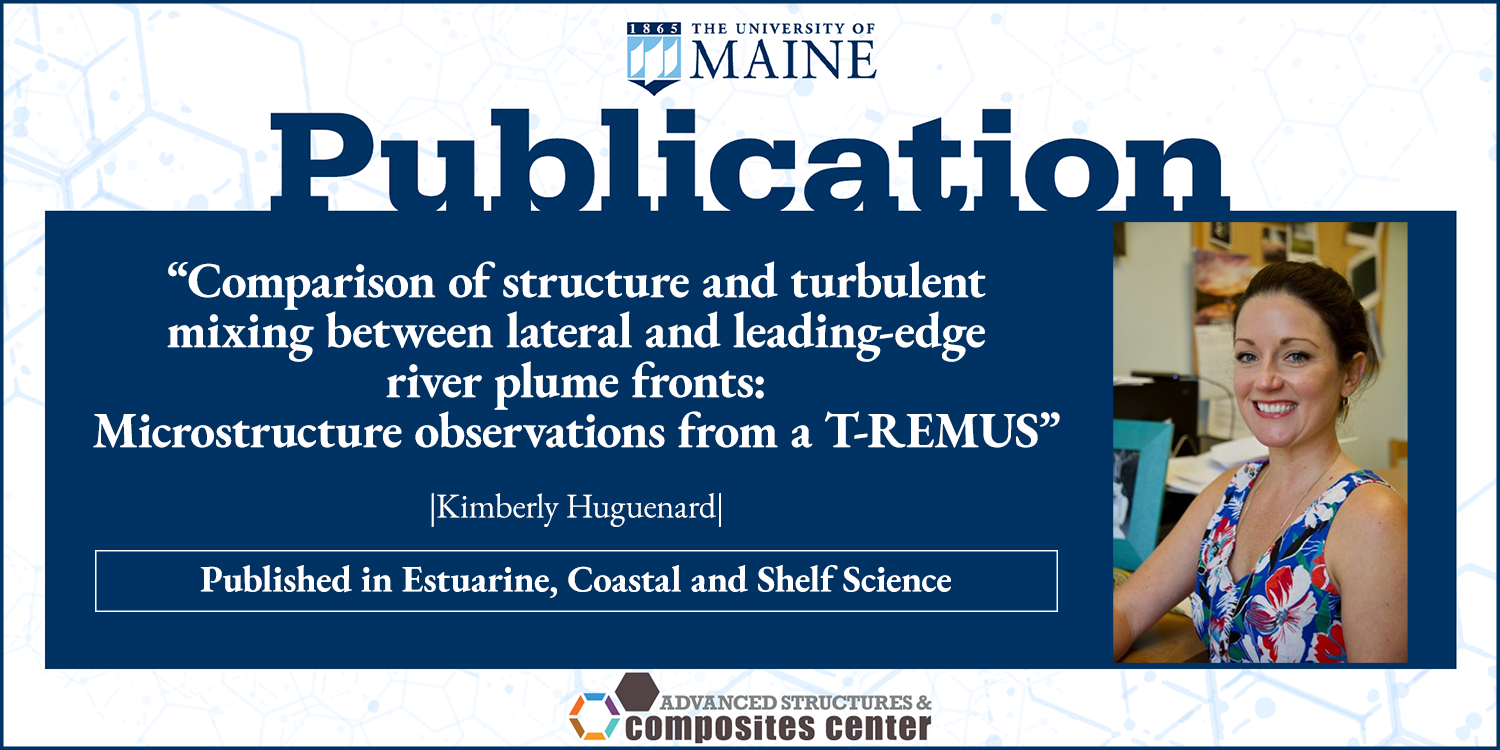
Article by Huguenard published in Estuarine, Coastal and Shelf Science
Orono, Maine — An article by ASCC researcher and professor of civil and environmental engineering Kimberly Huguenard titled “Comparison of structure and turbulent mixing between lateral and leading-edge river plume fronts: Microstructure observations from a T-REMUS AUV” was recently published in Estuarine, Coastal and Shelf Science.
The paper is co-authored by UMaine civil and environmental engineering professor Kelly Cole, and researchers from the University of Massachusetts Dartmouth and the University of Connecticut. The article describes how a T-REMUS Autonomous Underwater Vehicle (AUV) was used to sample the energetic region of the Connecticut River plume front, or features created around the perimeter of the river plumes that delineate the buoyant river discharge from the coastal ocean. The goal was to seek and address gaps using synchronous multiscale observations from an AUV that can provide repeated high-resolution views of front structure and turbulent mixing.
T-REMUS navigated ten cross-front transects at various depths while sampling the Connecticut River mouth, as direct observations of plumes have only been conducted at sparse temporal/spatial scales. Processes that occur at fronts are critical for understanding overall dilution and transport of plumes. Researchers found that the T-REMUS was successful in its sampling and the subsequent observations corroborate with the existing views on river plume fronts and their laboratory equivalents. It was discovered that the local dynamics primarily control turbulent kinetic energy dissipation rates in the near-frontal region of the river.
Comparison of structure and turbulent mixing between lateral and leading-edge river plume fronts: Microstructure observations from a T-REMUS AUV
Authors: Nikiforos Delatolas, Daniel G. MacDonald, Louis Goodman, Michael Whitney, Kimberly Huguenard, Kelly Cole
Estuarine, Coastal, and Shelf Science (2023)
Full Article
Received: 30 June 2022 / Accepted: 23 January 2023 / Published: 2 February 2023
Abstract
The energetic frontal region of the tidally pulsed Connecticut River plume was sampled with the T-REMUS Autonomous Underwater Vehicle (AUV) which navigated ten cross-front transects at various depths. Synchronous and high resolution hydrographic, microstructure, velocity and backscatter observations allowed the creation of detailed views of frontal structure and turbulent mixing in the reference frame of the propagating front. The front was defined by a sharp horizontal density gradient of ∼18.5 kg m−4 across only 0.7 m in the horizontal, and strong downwelling velocities of 0.17 m/s. Three successive zones were consistently identified. The first O (10 m) wide downwelling zone in which buoyant plume water was forced downward, thereby forming a highly energetic frontal head that extended down to 6 m depth and had TKE dissipation rates (ε) of order 10−3 m2/s3. Beyond the downwelling zone to O (100 m), a transition zone was observed, characterized by substantial entrainment of ambient water. This zone had high amplitude and high frequency density anomaly (σθ) variability consistent with elevated but decreasing turbulent kinetic energy dissipation rates (ε) which ranged between 10−4 and 10−5 m2/s3. Beyond O (100 m) from the front, stable stratification, high Ri values, and low Reb values, suppressed the growth of instabilities and diminished turbulent mixing. In this stable interior region the plume base shoaled to 2 m depth and ε decreased further, from 10−5 to 10−7 m2/s3. In ambient Long Island Sound waters, ε ranged between 10−6 and 10−7 m2/s3. The cross-front distributions of σθ and ε did not change substantially as the front transformed from a lateral boundary, where plume flow was primarily in the along-front direction, to one that was at the leading edge of the plume, where plume flow was mostly in the cross-front direction. In both cases, a significant convergence was present at the front due to strong ambient tidal velocities. The observed ε values and those from four previous studies of large and mid-sized plumes were nondimensionalized using the velocity and length scales associated with the downwelling region at the front. The effective normalization suggests that local dynamics primarily control ε in the near-frontal region.
Keywords: River plume; Turbulence; Autonomous underwater vehicle
Comparison of structure and turbulent mixing between lateral and leading-edge river plume fronts: Microstructure observations from a T-REMUS AUV
Contact: Grace Bradley, grace.a.bradley@umaine.edu
